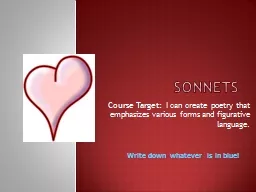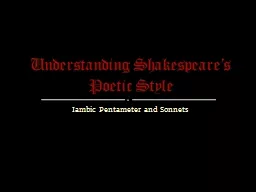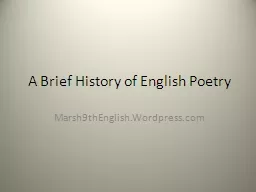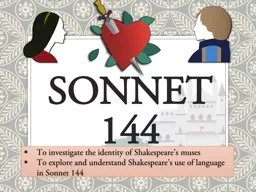PPT-Nearly Everything You Wanted to Know About [Shakespeare] Sonnets
Author : liane-varnes | Published Date : 2018-03-09
And Probably Didnt Want to Ask Sonnets 14 line lyric Single stanza Iambic pentameter line Intricate rhyme scheme Often written in narrative sequencessonnet
Presentation Embed Code
Download Presentation
Download Presentation The PPT/PDF document "Nearly Everything You Wanted to Know Abo..." is the property of its rightful owner. Permission is granted to download and print the materials on this website for personal, non-commercial use only, and to display it on your personal computer provided you do not modify the materials and that you retain all copyright notices contained in the materials. By downloading content from our website, you accept the terms of this agreement.
Nearly Everything You Wanted to Know About [Shakespeare] Sonnets: Transcript
And Probably Didnt Want to Ask Sonnets 14 line lyric Single stanza Iambic pentameter line Intricate rhyme scheme Often written in narrative sequencessonnet sequence Often concerned with love and desire. EQ: How can I understand Shakespeare & apply it to my life?. Shakespeare, alias the Bard. EQ: How can I apply Shakespeare to today’s . world or the world of early America?. Times. Elizabethan Age (era of peace after 100 Years War with France & the War of Roses, a civil war in England) . . . Time & money for the . The Poet. SHAKE-SPEARE’S SONNETS. Published in . 1609. . Thomas Thorpe was the publisher. Shakespeare did . not. give his approval. Thorpe was “cashing-in” on Shakespeare. Before attempting sonnets, Shakespeare wrote two . story. 1564 - 1616. Who was Shakespeare?. William Shakespeare was a poet, actor and playwright.. One of the world’s greatest playwrights of all time.. Writing in England during the late 1500’s and early 1600’s during the reigns of Queen Elizabeth I and King James I. . Not quite “much ado about nothing”. Shakespeare’s Sonnet #2. WHEN forty winters shall besiege thy brow . And dig deep trenches in thy beauty's field, . Thy youth's proud livery, so gazed on now, . Queen Elizabeth I - born September 7, 1533 in . Greenwich. Died March 24, 1603 in Richmond, Surrey. Daughter of King Henry VIII and Anne Boleyn . (. beheaded by Henry for not bearing a son). Coronated. Course Target: . I can create poetry that emphasizes various forms and figurative language.. Write down whatever is in blue!. A brief history of sonnets. Invented in Italy in the thirteenth century, the sonnet was brought to a high form of development in the fourteenth century by Francesco Petrarch (. Understanding Shakespeare’s Poetic Style. Shakespeare wrote 38 plays, including . Romeo & Juliet. .. He also wrote about 154 sonnets.. Shakespeare’s Sonnets. sonnet . : a fourteen-line poem. Most of Shakespeare’s sonnets dealt with themes like love, life and death, and beauty. . William Shakespeare. c. 1564-1616. b. Stratford-upon-Avon, England. Playwright, Poet, Actor. Most famous for his plays. All but 2 of his 154 sonnets were published in 1609. Shakespearean Sonnets. 1609: Quarto only source of most 152 Shakespearean Sonnets. . Definition. Sonnets are poems that usually just focus on one idea. The earliest sonnets were all about love. The name sonnet came from the Old French for little song. Sonnets always have fourteen lines. and Hamlet. Scansion. Elision. Voiced Syllable. Shared Line. Iamb. Trochee. Dactyl. Spondee. Anapest. Quatrain. Blank Verse. Free Verse. Heroic Couplet. Monometer. Dimeter. Trimeter. Tetrameter. Pentameter. T. he Legend. The . Dramatist. . And The Poet. THE LIFE OF A MAN. He. . was. . born. on the 23 of april 1564 in . Stratford. and 52 . years. later . he. . died. on his . birthday. . . When. Marsh9thEnglish.Wordpress.com. Major Eras of British/American Poetry. Elizabethan. Romantic. Victorian. Modernist. Post-Modernist. ELIZABETHAN PERIOD. 1558-1603. Elizabethan Age. The reign of Elizabeth I was also a. To . explore and understand Shakespeare’s use of language in Sonnet . 144. A Muse. The Muses are the inspirational goddesses of literature, science, and the arts in Greek mythology. . They . were considered the source of the knowledge . Charlotte Smith, Elegiac Sonnets (1784) Sonnet Revival Assumptions about the demise of the sonnet after Milton are based mainly on the fact that major authors such as Pope, Dryden and Johnson used the sonnet only sparingly, Pope published sonnets ‘in imitation of Waller’, aged thirteen.
Download Rules Of Document
"Nearly Everything You Wanted to Know About [Shakespeare] Sonnets"The content belongs to its owner. You may download and print it for personal use, without modification, and keep all copyright notices. By downloading, you agree to these terms.
Related Documents

![PPT-Nearly Everything You Wanted to Know About [Shakespeare] Sonnets](https://thumbs.docslides.com/645052/nearly-everything-you-wanted-to-know-about-shakespeare-sonnets.jpg)












